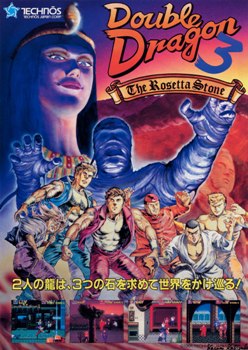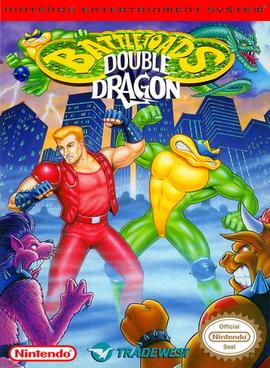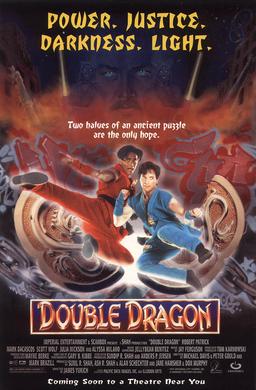Related Research Articles

Double Dragon is a beat 'em up video game series originally developed and published by Technōs Japan. It began with the release of the arcade game Double Dragon in 1987. The series features twin martial artists, Billy and Jimmy Lee, as they fight against various adversaries and rivals.

Super Double Dragon, released in Japan as Return of Double Dragon: "Sleeping Dragon" has Awoken, is a side-scrolling beat-'em-up released for the Super Nintendo Entertainment System in 1992. It was published by Tradewest in North America and the PAL region and by Technōs Japan in Japan. Super Double Dragon is the fourth console game in the Double Dragon series developed by Technōs Japan, following Double Dragon III: The Sacred Stones for the NES. The game did not have an arcade release and was made specifically for the home market.

Double Dragon II: The Revenge is a side-scrolling beat 'em up produced by Technōs Japan originally released as a coin-operated arcade game in 1988. It is the first sequel to Double Dragon, released during the previous year. The sequel involves Billy and Jimmy Lee in a mission to avenge Billy's girlfriend Marian after she is shot to death by the Black Warriors leader Willy, who is retaliating against the Lee brothers after his defeat at the end of the previous game. Double Dragon II was initially developed as an upgrade kit for the original Double Dragon, but evolved into a stand-alone game due to an increase in memory size, resulting in the developers reusing assets for both games.

Double Dragon Advance is a 2003 side-scrolling beat-em-up released for the Game Boy Advance. It was published by Atlus and developed by Japanese studio Million. It is a remake of the 1987 arcade game Double Dragon and incorporates elements from its sequels and home versions.

Double Dragon 3: The Rosetta Stone is a side-scrolling beat 'em up arcade game produced by Technōs Japan in 1990. It is the third arcade game in the Double Dragon series. Unlike the previous two games in the series, Double Dragon 3 was not developed internally at Technōs, but development was instead contracted to the company East Technology, resulting in a game that looks and plays differently from its predecessors.

Dungeons & Dragons is an American animated television series based on TSR's Dungeons & Dragons role-playing game. It is a co-production of Marvel Productions and TSR, with the Japanese Toei Animation. It ran on CBS from 1983 through 1985 for three seasons, for a total of twenty-seven episodes.
The Game of Death is an incomplete Hong Kong martial arts film, of which portions were filmed between September and October 1972, directed, written, produced by and starring Bruce Lee. The project was paused to film and produce Enter the Dragon. For The Game of Death, over 120 minutes of footage was shot, which was later misplaced in the Golden Harvest archives. The remaining footage has since been released with Lee's original Cantonese and English dialogue, with John Little dubbing Lee's Hai Tien character as part of the documentary titled Bruce Lee: A Warrior's Journey. Much of the footage that was shot is from what was to be the climax of the film.

Street Sharks is an American superhero animated series about the adventures of crime-fighting half-man/half-sharks. It was produced by DIC Productions, L.P. and Bohbot Entertainment, and aired from 1994 to 1997, originally as a part of Bohbot's Amazin' Adventures programming block. before moving to ABC for its final season. The show promoted a line of action figures by Mattel. The creators were David Siegel and Joe Galliani of Mr. Joe's Really Big Productions.

Battletoads/Double Dragon is a 1993 beat 'em up developed by Rare and published by Tradewest. It was originally released for the Nintendo Entertainment System and later ported to the Mega Drive/Genesis, Super NES, and Game Boy. Retro-bit Publishing has re-released the 8-bit NES version in early 2022 with plans to release the 16-bit versions later this year.

Double Dragon III: The Sacred Stones, released in Japan as Double Dragon III: The Rosetta Stone (ダブルドラゴンIII ザ・ロゼッタストーン), is a side-scrolling beat-'em-up produced for the Nintendo Entertainment System in 1991. It was the third Double Dragon game for the NES, developed by Technos Japan Corp. and published in North America and Europe by Acclaim Entertainment. Although loosely based on the similarly titled arcade game Double Dragon 3: The Rosetta Stone, it is not a port, but a parallel project that was developed at the same time.

Splinter, often referred to as Master Splinter or Sensei by his students/sons, is a fictional character from Teenage Mutant Ninja Turtles comics and all related media. A mutant rat, he is the grave and stoic sage of the Turtles, their ninjutsu and martial arts instructor, and their adoptive father. The character was originally a parody of the Marvel Comics character Stick.
Street Fighter is an animated television series based on the Street Fighter video game franchise by Capcom. The series aired as part of the USA Network's Cartoon Express and Action Extreme Team lineups. It aired 26 episodes across two 13-episode seasons, which aired from 1995 to 1997.

Extreme Dinosaurs is an American animated series produced by DIC Productions, L.P. and Bohbot Entertainment in 1997 based on a 1996 toy line from Mattel. This show is a spin-off of Street Sharks.

Double Dragon is a 1995 fighting video game spin-off of the Double Dragon series developed and published by Technōs Japan. It is based on the 1994 film, which in turn was based on the original arcade game. It was originally released for the Neo Geo and later released for the Neo Geo CD and PlayStation. It was Technōs Japan's last Double Dragon game before the company went out of business, and the fourth and final Double Dragon game released in arcades.

Double Dragon is a 1987 beat 'em up video game developed by Technōs Japan and distributed by Taito for arcades across Asia, North America and Europe. It is the first title in the Double Dragon franchise. The game's development was led by Yoshihisa Kishimoto, and it is a spiritual and technological successor to Technos' earlier beat 'em up, Nekketsu Kōha Kunio-kun (1986), released outside of Japan by Taito as Renegade; Kishimoto originally envisioned it as a direct sequel and part of the Kunio-kun series, before making it a new game with a different cast and setting.

Double Dragon is a 1994 American martial arts film, based on the video game series of the same name. The film was directed by James Yukich, whose previous credits include the Genesis music videos "That's All" and "Invisible Touch".

Double Dragon V: The Shadow Falls is a fighting game developed by Leland Interactive Media and published by Tradewest for the Super Nintendo Entertainment System and Sega Genesis in 1994. A port for the Atari Jaguar developed by Telegames was released the following year. It is an American-produced sequel to the Double Dragon series by Technōs Japan, who had little to no credited involvement in the development of the game outside of licensing the IP to the publisher outside Japan.

Battletoads is a video game media franchise by Rare that began with the original beat 'em up game Battletoads in 1991. Starring three anthropomorphic toads named after skin conditions, Rash, Zitz, and Pimple, the series was created to rival the Teenage Mutant Ninja Turtles games series. The original Battletoads game for the NES was renowned for its extreme difficulty, but still received a cult following, spawning sequels for various platforms including a crossover with the Double Dragon series and a modern reboot after a 25 year gap in releases. In each of the games, the objective is to defeat the toads' nemesis the Dark Queen and her army of space mutants.
Martial artist and actor Bruce Lee has been subject to extensive media coverage.

Double Dragon II: The Revenge is a side-scrolling beat-'em-up produced for the Nintendo Entertainment System in late 1989. It is the second Double Dragon game for the NES and was published in North America by Acclaim Entertainment, who took over publishing duties from Tradewest. The game shares its title with the 1988 arcade sequel to the original Double Dragon, using the same promotional artwork for its packaging and having a similar plot, but the content of the two games are otherwise drastically different. The NES version of Double Dragon II was directed by Hiroyuki Sekimoto, with the arcade version's director Yoshihisa Kishimoto taking a supervisory role in the game's development.
References
- ↑ Perlmutter, David (2018). The Encyclopedia of American Animated Television Shows. Rowman & Littlefield. p. 161. ISBN 978-1538103739.
- ↑ Erickson, Hal (2005). Television Cartoon Shows: An Illustrated Encyclopedia, 1949 Through 2003 (2nd ed.). McFarland & Co. pp. 279–280. ISBN 978-1476665993.
- ↑ Double Dragon The Animated Series
- ↑ "Discotek Licenses 1980 Astro Boy, Digimon Adventure, Symphogear GX, More Anime". 29 June 2023.